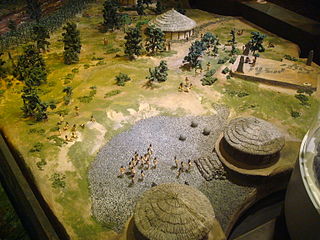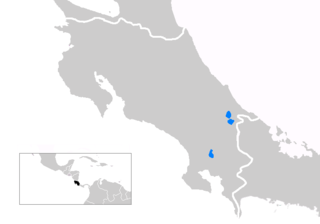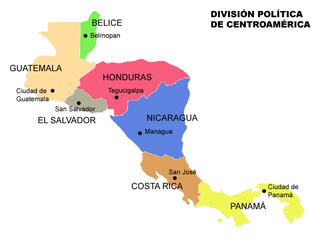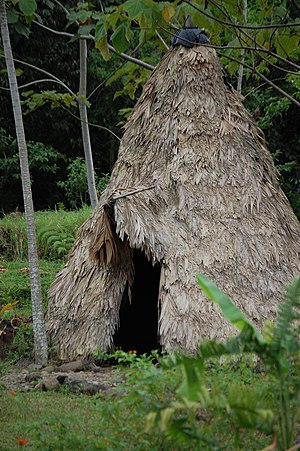
Costa Rica, officially the Republic of Costa Rica, is a country in the Central American region of North America, bordered by Nicaragua to the north, the Caribbean Sea to the northeast, Panama to the southeast, the Pacific Ocean to the southwest, and maritime border with Ecuador to the south of Cocos Island. It has a population of around five million in a land area of 51,060 km2 (19,710 sq mi). An estimated 333,980 people live in the capital and largest city, San José, with around two million people in the surrounding metropolitan area.

The first indigenous peoples of Costa Rica were hunters and gatherers, and when the Spanish conquerors arrived, Costa Rica was divided in two distinct cultural areas due to its geographical location in the Intermediate Area, between Mesoamerican and the Andean cultures, with influences of both cultures.

Costa Rican culture has been heavily influenced by Spanish culture ever since the Spanish colonization of the Americas including the territory which today forms Costa Rica. Parts of the country have other strong cultural influences, including the Caribbean province of Limón and the Cordillera de Talamanca which are influenced by Jamaican immigrants and indigenous native people, respectively.

Alajuela is a province of Costa Rica. It is located in the north-central part of the country, bordering Nicaragua to the north. It also borders the provinces of Heredia to the east, San José to the south, Puntarenas to the southwest and Guanacaste to the west. As of 2011, the province had a population of 885,571. Alajuela is composed of 16 cantons, which are divided into 111 districts. It covers an area of 9,757.53 square kilometers.

Monteverde is the twelfth canton of the Puntarenas province of Costa Rica. It is located in the Cordillera de Tilarán mountain range. Roughly a four-hour drive from the Central Valley, Monteverde is one of the country's major ecotourism destinations. The area is host to the Monteverde Cloud Forest Reserve and several other natural attractions, which draw considerable numbers of tourists and naturalists.

The Isthmo-Colombian Area is defined as a cultural area encompassing those territories occupied predominantly by speakers of the Chibchan languages at the time of European contact. It includes portions of the Central American isthmus like eastern El Salvador, eastern Honduras, Caribbean Nicaragua, Costa Rica, Panama, and northern Colombia.

The Naso or Teribe people are an indigenous people of Panama and Costa Rica. They primarily live in northwest Panama in the Bocas del Toro Province and Naso Tjër Di Comarca. There are roughly 3,500 people who belong to the Naso tribe. It is one of the few Native American indigenous groups or tribes that continues to have a monarchy.

The Bribri are an Indigenous people in eastern Costa Rica and northern Panama. Today, most Bribri people speak the Bribri language or Spanish.

Central America is a subregion of the Americas formed by six Latin American countries and one (officially) Anglo-American country, Belize. As an isthmus it connects South America with the remainder of mainland North America, and comprises the following countries : Belize, Guatemala, Honduras, El Salvador, Nicaragua, Costa Rica, and Panama.

The Boruca are the indigenous people living in Costa Rica. The tribe has about 2,660 members, most living on a reservation in the Puntarenas Province in southwestern Costa Rica, a few miles away from the Pan-American Highway following the Rio Terraba. The ancestors of the modern Boruca made up a group of chiefdoms that ruled most of Costa Rica's Pacific coast, from Quepos to what is now the Panamanian border, including the Osa Peninsula. Boruca traditionally spoke the Boruca language, which is now nearly extinct.
The Maléku Jaíka language, also called Malecu, Maleku, Guatuso, Watuso-Wétar, and Guetar, is an Indigenous American language in Costa Rica.

Guatuso is a canton in the Alajuela province of Costa Rica.

The Spanish conquest of the Chibchan nations refers to the conquest by the Spanish monarchy of the Chibcha language-speaking nations, mainly the Muisca and Tairona that inhabited present-day Colombia, beginning the Spanish colonization of the Americas.
Costa Rica's official and predominant language is Spanish. The variety spoken there, Costa Rican Spanish, is a form of Central American Spanish.

Indigenous people of Costa Rica, or Native Costa Ricans, are the people who lived in what is now Costa Rica prior to European and African contact and the descendants of those peoples. About 114,000 indigenous people live in the country, comprising 2.4% of the total population. Indigenous Costa Ricans strive to keep their cultural traditions and language alive.

Costa Ricans, also called Ticos, are the citizens of Costa Rica, a multiethnic, Spanish-speaking nation in Central America. Costa Ricans are predominantly Castizos, other ethnic groups people of Indigenous, European, African and Asian descent.
The lands inhabited by indigenous peoples receive different treatments around the world. Many countries have specific legislation, definitions, nomenclature, objectives, etc., for such lands. To protect indigenous land rights, special rules are sometimes created to protect the areas they live in. In other cases, governments establish "reserves" with the intention of segregation. Some indigenous peoples live in places where their right to land is not recognised, or not effectively protected.

The Cabécar are an indigenous group of the remote Talamanca region of eastern Costa Rica. They speak Cabécar, a language belonging to the Chibchan language family of the Isthmo-Colombian Area of lower Central America and northwestern Colombia. According to census data from the National Institute of Statistics and Census of Costa Rica, the Cabécar are the largest indigenous group in Costa Rica with a population of nearly 17,000.

According to Costa Rica’s 1977 Indigenous Law, the Indigenous Territories are the traditional lands of the legally recognized indigenous peoples of Costa Rica. The Republic of Costa Rica recognizes eight native ethnicities; Bribris, Chorotegas, Malekus, Ngöbe, Huetars, Cabecars, Borucas and Terrabas.
Lake Cote, originally known as Lake Cóter, is a fresh water crater lake located in the northern highlands of Costa Rica. It is currently the largest natural lake in Costa Rica at 1.98-square-kilometre (0.76 sq mi). Its depth varies between 6 and 18 meters.














